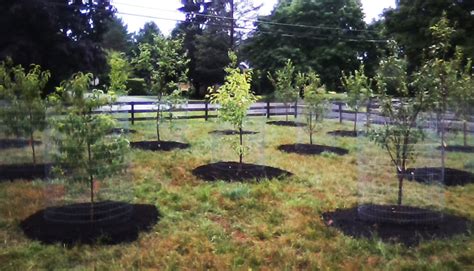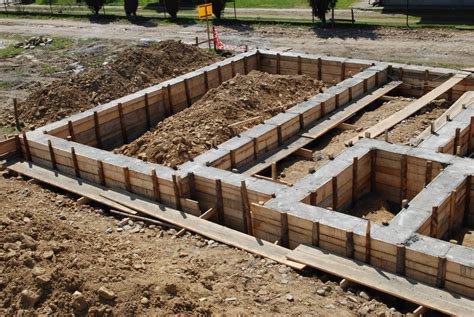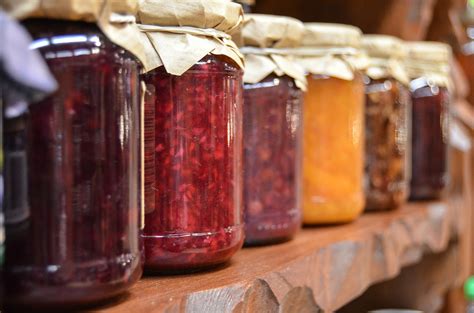Have you ever envisioned the remarkable venture of cultivating a thriving fruit garden, creating an idyllic haven where lush trees bear bountiful harvests? This idealistic notion of nurturing an abundance of nature's gifts holds an undeniable appeal, capturing the imagination of many aspiring horticulturists.
Engrossed in the pursuit of establishing your very own flourishing orchard, you passionately pursue the knowledge and expertise required to transform your reverie into a tangible reality. The path towards achieving this ambition demands dedication, perseverance, and a profound understanding of nature's rhythms.
Within these pages, we embark on a journey that unfolds the secrets and techniques of orchard cultivation, offering valuable insights and recommendations to fuel your passion. Delve into the realms of horticulture and discover the intricacies of nurturing fruit-bearing trees, and the gratification that awaits those who undertake this soul-enriching endeavor.
Finding the Perfect Location for Your Orchard

When it comes to establishing a thriving orchard, selecting the right location is paramount. The success of your orchard depends on various factors, including climate, soil conditions, and access to essential resources. In this section, we will explore the key considerations to keep in mind when choosing the ideal location for your blossoming fruit garden.
Climate: The climate of your chosen region plays a vital role in determining the types of fruit trees that will flourish in your orchard. Different fruit trees have specific temperature and weather requirements, so it is crucial to research the climatic conditions that favor the fruits you wish to grow. Consider the average monthly temperatures, frost dates, rainfall patterns, and potential risks of extreme weather events when selecting your orchard's location.
Soil Quality: The soil is the foundation of a healthy and productive orchard. The composition and fertility of the soil directly impact the growth and yield of your fruit trees. Conduct soil tests to assess its pH level, nutrient content, and drainage capabilities. Determine whether the soil type is suitable for the fruit trees you plan to cultivate, as different trees thrive in different soil conditions. Additionally, look out for any potential contamination or pollution sources that could harm your orchard's long-term health.
Sun Exposure: Adequate sunlight is essential for the growth and development of fruit trees. When scouting for an orchard location, consider the amount of sunlight the area receives throughout the year and the potential shade cast by nearby structures or trees. Fruit trees generally require a minimum of six hours of direct sunlight daily. Ensure the chosen location provides ample exposure to maximize fruit production and enhance overall tree health.
Water Availability: Water is crucial for the survival and growth of your fruit trees. Evaluate the water sources available in the vicinity of your prospective orchard location. Consider the accessibility and reliability of these sources, as well as any potential water restrictions or limitations in the area. Adequate irrigation systems, such as ponds or wells, may need to be incorporated into your orchard plan to ensure consistent and efficient water supply to your trees.
Proximity to Market: If you plan to sell your fruits commercially or distribute them locally, it is important to consider the proximity of your orchard to potential markets. Being close to consumers reduces transportation costs and enhances the freshness and quality of your products. Research the demand for your chosen fruits in the surrounding areas and assess the existing competition before finalizing the location of your orchard.
By considering these key factors when selecting the location for your orchard, you will be laying a solid foundation for a thriving and fruitful venture. Take your time, do your research, and make an informed decision that aligns with your goals and vision for your orchard.
Selecting the most suitable fruit tree varieties
When embarking on the journey of nurturing and growing your own bountiful orchard, one of the crucial decisions to make is selecting the best fruit tree varieties that will thrive in your specific environment. Choosing the right fruit tree varieties is essential for ensuring a successful and fruitful orchard that can be enjoyed for years to come.
Variety selection:
First and foremost, you need to consider the specific characteristics and requirements of the various fruit tree varieties available. Each variety has its own unique qualities, such as taste, appearance, growing conditions, disease resistance, and harvest time. By understanding these distinctions, you can make informed decisions to ensure the best chance for success in your orchard.
Adaptability:
It is important to ensure that the fruit tree varieties you choose are well-suited to the local climate and growing conditions. Some varieties may thrive in temperate regions, while others are better suited to warmer or cooler climates. Understanding the adaptability of each variety will help you select the ones that will thrive and produce abundant fruits in your specific location.
Space and pollination requirements:
Consider the amount of space you have available for your fruit trees and their specific pollination requirements. Some fruit tree varieties require cross-pollination with compatible varieties for optimal fruit production. Understanding the pollination needs of the different varieties will help you plan the layout of your orchard and ensure proper pollination for maximum fruit yield.
Disease resistance:
Another important factor to consider when selecting fruit tree varieties is their resistance to common diseases and pests in your area. Some varieties exhibit natural resistance to specific diseases, reducing the need for chemical interventions and promoting a healthier, more sustainable orchard. Researching the disease resistance of different varieties will help you make choices that can contribute to the long-term success of your orchard.
Taste and intended use:
Finally, consider the taste and intended use of the fruits produced by each variety. Some fruits are prized for their exquisite flavor when eaten fresh, while others are better suited for cooking, canning, or making preserves. Knowing the desired use for the fruits will help you select the varieties that align with your personal preferences and culinary needs.
In conclusion,
Choosing the best fruit tree varieties is a meticulous process that requires careful consideration of adaptability, pollination requirements, disease resistance, taste, and intended use. By taking the time to research and select the varieties that are most suitable for your orchard, you can increase your chances of successfully cultivating a thriving and abundant fruit orchard for years to come.
Building the Foundation for a Flourishing Orchard

Establishing a successful orchard requires careful planning, meticulous execution, and a deep understanding of the essential steps involved. This section outlines the fundamental aspects to consider when embarking on the journey of creating your own thriving orchard.
- Choose the Perfect Location
- Prepare the Soil
- Select the Right Varieties
- Source High-Quality Planting Material
- Plan and Implement Efficient Irrigation Systems
- Implement Proper Pruning Techniques
- Monitor Pest and Disease Control
- Maintain Adequate Nutrient Supply
- Follow Best Harvesting and Storage Practices
One of the key factors in establishing a successful orchard is selecting the perfect location. The choice of site should consider factors such as sunlight exposure, soil type, drainage, and proximity to water sources. Adequate soil preparation is essential to provide a healthy foundation for the orchard. This involves soil testing, amending the soil with organic matter, and ensuring proper drainage. The next step involves selecting the right varieties of fruit trees that are well-suited to the climate, soil conditions, and intended purpose of the orchard. It is crucial to acquire high-quality planting material from reputable nurseries to ensure healthy and productive trees.
An efficient and reliable irrigation system is crucial for the proper growth and development of the trees. Careful consideration should be given to choosing an appropriate irrigation method and implementing it effectively. Regular pruning plays a vital role in shaping the trees, promoting airflow, and maintaining optimal fruit-bearing capacity. Monitoring and implementing effective pest and disease control measures are vital to protect the orchard from potential threats. Additionally, providing the trees with adequate nutrients through proper fertilization practices is necessary to support their overall health and productivity.
Lastly, following best harvesting techniques and proper storage practices are crucial to ensure the quality and longevity of the harvested fruits. These essential steps lay the foundation for a flourishing orchard, setting the stage for long-term success and rewarding harvests.
Nurturing your orchard: Watering, fertilizing, and pest control
Ensuring the health and productivity of your orchard involves a careful balance of essential practices, including proper watering techniques, effective fertilizer application, and proactive pest control measures. By employing these integral strategies, you can cultivate a thriving orchard brimming with luscious fruits and vibrant foliage.
Watering: Adequate and timely watering is crucial for the well-being of your orchard. Regularly monitoring soil moisture levels and providing sufficient irrigation to meet the specific needs of your fruit trees promotes healthy root development and optimum growth. Implementing efficient watering methods, such as drip irrigation or soaker hoses, can help minimize water wastage while ensuring that the trees receive adequate hydration.
Fertilizing: A well-rounded fertilizing regimen is essential for supplying the necessary nutrients that bolster the vitality of your orchard. Utilizing organic fertilizers, such as compost or well-rotted manure, enriches the soil and improves overall fertility. Additionally, incorporating balanced commercial fertilizers tailored to the specific nutrient requirements of your trees can further enhance their growth and fruit production. It is vital to follow recommended application rates and timing to avoid over-fertilization, which could lead to detrimental effects.
Pest control: Protecting your orchard from destructive pests is a crucial aspect of successful orchard management. Implementing integrated pest management (IPM) techniques allows for a harmonious coexistence with beneficial insects and minimized reliance on chemical pesticides. Regular monitoring and early detection of pests enable timely intervention, thus minimizing potential damage. Utilizing natural pest control methods, such as introducing beneficial insect species or using biological insecticides, can help tackle pest infestations effectively while minimizing environmental impact.
By nurturing your orchard through optimal watering practices, nutrient-rich fertilization, and diligent pest control, you can create an environment that fosters healthy tree growth, abundant blossoms, and bountiful harvests. Consistency and attention to detail will undoubtedly reward you with the orchard of your dreams.
Harvesting and Preserving the Fruits of Your Hard Work

Once your treasured orchard has blossomed and thrived, it is time to reap the rewards of your diligent efforts. In this section, we will explore the process of harvesting and preserving the delectable fruits that have flourished under your care. As each season unfolds, the bountiful harvest awaits, offering a sense of fulfillment, satisfaction, and the opportunity to relish nature's gifts.
Harvesting:
When the time comes to gather the fruits of your labor, careful planning is key. With a myriad of ripe apples, pears, or citrus fruits at your disposal, it is crucial to select the perfect moment to pick them. Relying on visual cues, such as vibrant colors and smooth textures, alongside aromatic scents, ensures that you harvest the fruit at its peak ripeness. Employing gentle twisting motions or utilizing pruners will safeguard both the delicate fruit and the tree itself. Remember, each fruit harvested is a testament to your dedication and expertise.
Preservation:
Preserving the precious flavors and textures of your harvested fruits allows you to extend their enjoyment throughout the year. Be it jams, jellies, compotes, or canned delights, there are numerous preservation methods to explore. The traditional art of canning, with its precise measuring, sterilization, and sealing, ensures your fruits retain their taste and nutritional value. Additionally, dehydrating fruits as wholesome snacks or creating tantalizing fruit preserves provides a burst of summer's sweetness long after the trees shed their leaves.
Remember to experiment and get creative with various recipes and preservation techniques. Exploring flavors and textures will enable you to savor the essence of your orchard year-round while sharing its harvest with loved ones.
FAQ
What types of fruits are recommended for starting a fruitful orchard?
When starting a fruitful orchard, it is recommended to choose fruit trees that are well-suited to the local climate and soil conditions. Popular fruit tree options include apple, pear, peach, cherry, plum, and citrus trees. It is also important to consider factors such as disease resistance and the specific requirements of each fruit tree variety.
How much space is required to establish a fruitful orchard?
The space required for a fruitful orchard depends on the number of fruit trees you plan to have and their planting arrangement. On average, fruit trees need about 15 to 20 feet of space between each other to allow for proper air circulation and sunlight exposure. The total area of the orchard will also depend on the size of each tree at maturity. It is recommended to plan ahead and provide enough space for future growth needs.
What are some essential tips for maintaining a fruitful orchard?
Maintaining a fruitful orchard requires regular care and attention. Some essential tips include proper watering, fertilizing, and pruning of the fruit trees. Watering should be done deeply and infrequently, ensuring that the trees receive enough moisture without becoming waterlogged. Fertilizing should be carried out according to the specific needs of each fruit tree variety. Pruning helps in controlling the tree's shape, improving air circulation, and enhancing fruit production. Additionally, it is important to regularly monitor and address any pest or disease issues.
Are there any potential challenges or risks in owning a fruitful orchard?
Owning a fruitful orchard comes with its own challenges and risks. One potential challenge is the need for continuous maintenance and active management of the orchard. This requires time, effort, and knowledge. The risk of pest infestations, diseases, and unfavorable weather conditions can also affect the overall health and productivity of the fruit trees. It is important to stay informed about potential risks and take preventive measures to minimize their impact on the orchard.



